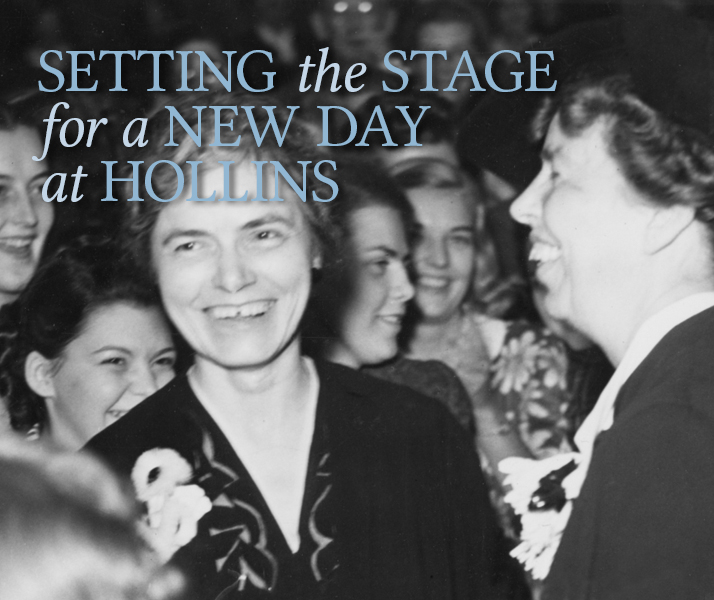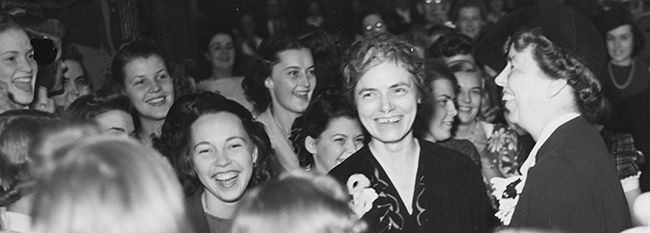
Setting the stage for a new day at Hollins
Bessie Carter Randolph 1912, Hollins’ third president, saw the institution through its critical transition from a family-owned enterprise to an accredited college poised for national recognition.
By Brenda McDaniel HON ’12

Bessie Carter Randolph with First Lady Eleanor Roosevelt, who spoke on campus in October 1938
Bessie Carter Randolph 1912 became the third president of Hollins College in the middle of the Great Depression, 1933. A serious, scholarly woman with a Ph.D. from Radcliffe, a seasoned history and political science professor, she must have known it wasn’t the best time to take over a small struggling woman’s college that was just transitioning from a family owned and operated enterprise to an accredited college with a public board of trustees.
And you can’t say she wasn’t warned. Even at her inauguration, the first in Hollins’ 90-year history, on Founder’s Day, February 21, 1934, just five days shy of her 49th birthday, her inauguration speaker, the president of Vassar College, told those gathered for the occasion:
The “office (of president) is one of the hazardous occupations, for the average term of a college president is eleven years. If by reason of grace it be extended to twenty, still after the first eleven all is weariness of the flesh and vexation of the spirit.”
Bessie Carter Randolph would encounter many vexations of the spirit during her term, which would span the next 17 years through the remaining years of the Depression and all of World War II. It wasn’t easy. Finances were always tight, and Hollins often had to borrow money to make ends meet. Students were hard to come by and hard to keep during the Depression and war years.
If Randolph had wanted to leave her mark on Hollins in the form of fancy buildings, the times were not on her side. But as an academic with guts, determination, and tough-minded focus, she stewarded Hollins through the worst hard times and paved the way for future success.
Her greatest accomplishments were in the areas of academics, faculty salaries, fundraising, and alumnae engagement. She immediately set out to evaluate the curriculum and reorganize the academic departments into four divisions, and by 1935 Hollins was accredited by all standardizing agencies.
Randolph understood the importance of public relations, development, and alumnae relations. She cultivated the interest of Mrs. Alfred I. (Jessie Ball) duPont and induced her to become a generous donor and trustee. As a result, the duPont endowments continue to benefit Hollins, especially faculty salaries.
She dogged her alumnae office, insisting they do more public relations and visit more alumnae chapters when travel was possible. She launched an annual two-week summer alumnae institute.
A highlight of her presidency was Hollins’ centennial in 1942. A 75th anniversary celebration had been canceled in 1917 because of World War I. Randolph and others decided in 1940 that the centennial must go on despite gathering clouds of yet another world war.
Presaging Nancy Gray’s own sentiments about the 175th anniversary, Randolph said her general idea was to “consider 1942 as a beginning year, rather than as a consummation – a looking forward rather than backwards.”
Although the trustees named a dormitory Randolph Hall in her honor after she retired, the only buildings representing Randolph’s presidency are Barbee House, built as a faculty residence in 1936-37, Tinker Tea House (now Cromer Bergman Alumnae House), for which alumnae raised the funds, and the Art Annex, a cinder block and brick compromise stuck onto the Little Theatre to give art faculty much-needed space in 1948. Other funds, as they became available, were invested in unglamorous infrastructure improvements and rebuilding the rear wall of East in 1945.
While the Hollins endowment doubled, to $734,000, during Randolph’s presidency, it wasn’t enough. “This college should have endowed funds of $1.5 million at the very least,” she told the trustees in her final report to them on June 19, 1950.
She expressed other disappointments about her 17-year tenure as well. For example, she had tried throughout her career to get a chapter of Phi Beta Kappa for Hollins, but a number of factors prevented it. It was as president emerita that she attended the inaugural meeting of the Iota Chapter of PBK in 1962, 12 years after she had retired.
Her final report also noted the standing problems of too few students (only 339 in 1949-50), too few graduates (57), too many students who dropped for academic performance, flat enrollment for the coming year, and a library (Cocke Building) that “continues to be a glaring problem” with too little space for books or readers. She reminded the board that the General Education Board in April 1947 had pledged $25,000 toward a new library building if Hollins could raise matching funds. The offer would expire on December 31 if not met.
And she mentioned something that had bothered her for a long time: “One field of our public relations is being neglected year after year—the colored community at our very doors. This group of friends needs an investment of money and still more of time, and their welfare should be guarded and promoted as far as we can possibly do so.”
In her parting words to the trustees, Bessie Carter Randolph sounded weary and vexed of spirit, yet that is not known to be her reason for retiring at age 65. It was the mandatory retirement age for Hollins employees at the time.
In the summer of 1950, she left Hollins in the hands of the 31-year-old charismatic Columbia University-educated John “Jack” Everett. He would have a quick takeoff. The country was in better shape financially and psychologically, and thanks to Bessie Carter Randolph, Hollins was debt free, fully accredited, and had a new campus architectural plan started in 1940 but unfortunately postponed by war. It was a new day for Hollins, but one for which Bessie Carter Randolph had set the stage.
President Emerita Randolph moved to an apartment in Lynchburg, where she read, wrote, lectured, and remained active in the American Association of University Women, the Women’s Club, and the American Society of International Law. She stayed in touch with Hollins classmates, alumnae, and colleagues and visited often until becoming ill in the early 1960s. She died in 1966 at age 81 and is buried in Lynchburg.
Brenda McDaniel is the retired executive director of donor relations.
